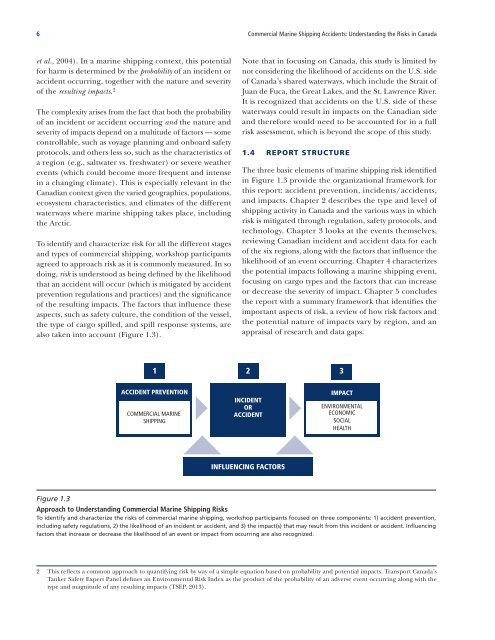Commercial Marine Shipping Accidents Understanding Risks Canada
cca_marine_shipping_risks_en_fullreport
cca_marine_shipping_risks_en_fullreport
You also want an ePaper? Increase the reach of your titles
YUMPU automatically turns print PDFs into web optimized ePapers that Google loves.
6 <strong>Commercial</strong> <strong>Marine</strong> <strong>Shipping</strong> <strong>Accidents</strong>: <strong>Understanding</strong> the <strong>Risks</strong> in <strong>Canada</strong><br />
et al., 2004). In a marine shipping context, this potential<br />
for harm is determined by the probability of an incident or<br />
accident occurring, together with the nature and severity<br />
of the resulting impacts. 2<br />
The complexity arises from the fact that both the probability<br />
of an incident or accident occurring and the nature and<br />
severity of impacts depend on a multitude of factors — some<br />
controllable, such as voyage planning and onboard safety<br />
protocols, and others less so, such as the characteristics of<br />
a region (e.g., saltwater vs. freshwater) or severe weather<br />
events (which could become more frequent and intense<br />
in a changing climate). This is especially relevant in the<br />
Canadian context given the varied geographies, populations,<br />
ecosystem characteristics, and climates of the different<br />
waterways where marine shipping takes place, including<br />
the Arctic.<br />
To identify and characterize risk for all the different stages<br />
and types of commercial shipping, workshop participants<br />
agreed to approach risk as it is commonly measured. In so<br />
doing, risk is understood as being defined by the likelihood<br />
that an accident will occur (which is mitigated by accident<br />
prevention regulations and practices) and the significance<br />
of the resulting impacts. The factors that influence these<br />
aspects, such as safety culture, the condition of the vessel,<br />
the type of cargo spilled, and spill response systems, are<br />
also taken into account (Figure 1.3).<br />
Note that in focusing on <strong>Canada</strong>, this study is limited by<br />
not considering the likelihood of accidents on the U.S. side<br />
of <strong>Canada</strong>’s shared waterways, which include the Strait of<br />
Juan de Fuca, the Great Lakes, and the St. Lawrence River.<br />
It is recognized that accidents on the U.S. side of these<br />
waterways could result in impacts on the Canadian side<br />
and therefore would need to be accounted for in a full<br />
risk assessment, which is beyond the scope of this study.<br />
1.4 REPORT STRUCTURE<br />
The three basic elements of marine shipping risk identified<br />
in Figure 1.3 provide the organizational framework for<br />
this report: accident prevention, incidents/accidents,<br />
and impacts. Chapter 2 describes the type and level of<br />
shipping activity in <strong>Canada</strong> and the various ways in which<br />
risk is mitigated through regulation, safety protocols, and<br />
technology. Chapter 3 looks at the events themselves,<br />
reviewing Canadian incident and accident data for each<br />
of the six regions, along with the factors that influence the<br />
likelihood of an event occurring. Chapter 4 characterizes<br />
the potential impacts following a marine shipping event,<br />
focusing on cargo types and the factors that can increase<br />
or decrease the severity of impact. Chapter 5 concludes<br />
the report with a summary framework that identifies the<br />
important aspects of risk, a review of how risk factors and<br />
the potential nature of impacts vary by region, and an<br />
appraisal of research and data gaps.<br />
1 2 3<br />
ACCIDENT PREVENTION<br />
COMMERCIAL MARINE<br />
SHIPPING<br />
INCIDENT<br />
OR<br />
ACCIDENT<br />
IMPACT<br />
ENVIRONMENTAL<br />
ECONOMIC<br />
SOCIAL<br />
HEALTH<br />
INFLUENCING FACTORS<br />
Figure 1.3<br />
Approach to <strong>Understanding</strong> <strong>Commercial</strong> <strong>Marine</strong> <strong>Shipping</strong> <strong>Risks</strong><br />
To identify and characterize the risks of commercial marine shipping, workshop participants focused on three components: 1) accident prevention,<br />
including safety regulations, 2) the likelihood of an incident or accident, and 3) the impact(s) that may result from this incident or accident. Influencing<br />
factors that increase or decrease the likelihood of an event or impact from occurring are also recognized.<br />
2 This reflects a common approach to quantifying risk by way of a simple equation based on probability and potential impacts. Transport <strong>Canada</strong>’s<br />
Tanker Safety Expert Panel defines an Environmental Risk Index as the product of the probability of an adverse event occurring along with the<br />
type and magnitude of any resulting impacts (TSEP, 2013).


